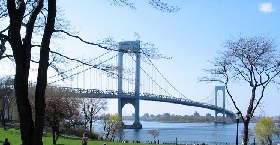|
|
New York - New York City - The Bronx
 The Bronx, geographically an unbroken extension of Westchester County (of which it was once a political division), is the only New York borough on the mainland. It occupies an area of 42 square miles (with so miles of water front), and lies at the northern extremity of the city -- in the upper portion of a "Y" formed by the East and Harlem rivers. The Hudson flows past the upper western flank of the borough, and Long Island Sound ends among the islands off the eastern shore. Across the narrow, high-banked Harlem is Manhattan, its long northern extremity snuggling against the Bronx and joined to it by fourteen bridges and three subway tunnels; beyond the flat, irregular shores of the East River is Long Island, linked to the Bronx by the Triborough, New York Connecting Railroad, and Bronx-Whitestone bridges. The Bronx, geographically an unbroken extension of Westchester County (of which it was once a political division), is the only New York borough on the mainland. It occupies an area of 42 square miles (with so miles of water front), and lies at the northern extremity of the city -- in the upper portion of a "Y" formed by the East and Harlem rivers. The Hudson flows past the upper western flank of the borough, and Long Island Sound ends among the islands off the eastern shore. Across the narrow, high-banked Harlem is Manhattan, its long northern extremity snuggling against the Bronx and joined to it by fourteen bridges and three subway tunnels; beyond the flat, irregular shores of the East River is Long Island, linked to the Bronx by the Triborough, New York Connecting Railroad, and Bronx-Whitestone bridges. The Bronx, the only borough of the Greater City on the mainland, has 1,357,589 people on its 41.4 square miles. As late as 1850 its population, largely German, was but 8,000. Annexation of West Bronx to New York in 1874 and of East Bronx in 1895 encouraged development. Hordes of immigrants from the East Side of Manhattan, seeking more commodious quarters, moved in. In 1938 half the population was Jewish, the remainder a medley of other national groups.
The borough is primarily a residential area. West Bronx contains over three fourths of the population; East Bronx, less prosperous neighbor, is yielding some of its congestion to districts northward. Eastchester retains something of its early rural atmosphere. The Bronx boasts more park acreage than any of the other boroughs.
The Bronx played no outstanding role in the Revolution. The great families were divided in their allegiance, and the Anglican clergy was, of course, Tory; the small farmers to a large degree held themselves aloof from the Revolution. A number of forts were built or occupied by the British, and though no large-scale battles took place in the Bronx, there were constant encounters and pillagings. Early in the war, according to Rupert Hughes' Washington, the British War Office, uninformed as to Bronx topography, issued orders to Admiral Howe to sail his fleet up the Bronx River and attack "whatever American ships he found there."
POINTS OF INTEREST
THE BRONX COUNTY BUILDING ( 1934), 161st St. and Grand Concourse, by Joseph H. Freedlander and Max Hausle, is a modern courthouse.
POE COTTAGE, Kingsbridge Rd. and Grand Concourse, a restored five-room frame house, was the home of Edgar Allan Poe during the last three years of his life ( 1846-9). It contains the bed in which Virginia Poe died, and a mirror, rocker, Bible, and spoon that belonged to the Poes.
HALL OF FAME ( 1901) (accessible any time from either University or Sedgwick Aves.), New York University, University Heights opposite W. 181st St., by Stanford White, is an arc-shaped colonnade integrating three beautiful buildings into a single handsome composition. Most illustrious of those represented by statuary in the Hall are Alexander Hamilton, Washington Irving, William Cullen Bryant, and Henry Ward Beecher.
FORDHAM UNIVERSITY (founded 1841), Fordham Rd. and Third Ave., is one of the largest Catholic educational institutions in the U.S.
BRONX PARK (IRT Bronx Park subway), Bronx Park E. and 180th St., covers 700 acres. Its most notable feature is the ZOOLOGICAL PARK (the Zoo).
VAN CORTLANDT PARK (IRT Broadway-Seventh Ave. subway to 242d St. station), Broadway and 242d St., 1,132 acres, has two 18-hole golf courses, 21 baseball diamonds, tennis courts, horseshoe pitching courts, 2 cricket fields, 15 miles of bridle paths, archery and hockey fields, skiing hills, boating and ice skating, hiking trails, bird sanctuaries, children's day camps, wooded sections, meadows. The VAN CORTLANDT HOUSE MUSEUM is near the entrance at Broadway and 242d St., on a high bluff overlooking the lake. A gray stone structure, fine example of Georgian Colonial architecture ( 1748), it was occupied by Washington for a short time after the Revolution. The Museum contains a collection of Dutch and Colonial furniture and an exhibit of ancient arms and documents. North of the mansion is Vault Hill, site of the Van Cortlandt burial ground.
ORCHARD BEACH, in Pelham Bay Park, Eastern Blvd. and Westchester Ave., was constructed with WPA aid. Opened to the public in 1936. It contains a bathing pavilion, free playgrounds for children, game area, loggia, cafeteria; the Split Rock and Pelham Bay Golf Courses are about 1 m. from beach.
|
|
This website is created and designed by Atlantis International, 2006
This is an unofficial website with educational purpose. All pictures, and trademarks are the property of their respective owners and may not be reproduced for any reason whatsoever. If proper notation of owned material is not given please notify us so we can make adjustments. No copyright infringement is intended.



